Exercise 2: Logistic Regression
==================== Part 1: Plotting ====================
from ex2 import *
import pandas as pd
## Load Data
# The first two columns contains the exam scores and the third column
# contains the label.
data = pd.read_csv('ex2data1.txt', header=None)
X = data.iloc[:, :2]
y = data.iloc[:, 2]
print('Plotting data with + indicating (y = 1) examples and o indicating (y = 0) examples.')
%matplotlib inline
plotData(np.array(X), np.array(y))
# Put some labels
# Labels and Legend
plt.xlabel('Exam 1 score')
plt.ylabel('Exam 2 score')
# Specified in plot order
plt.legend(['Admitted', 'Not admitted'])
plt.show()
Plotting data with + indicating (y = 1) examples and o indicating (y = 0) examples.
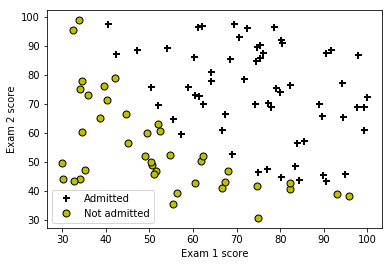
============ Part 2: Compute Cost and Gradient ============
代价函数
\[J(\theta) = \frac{1}{m}\sum_{i=1}^{m}{-y^{(i)}\log\left(h_\theta(x^{(i)})\right) - (1 - y^{(i)})\log\left(1 - h_\theta(x^{(i)})\right)}\] \[= -\frac{1}{m}\left(y^T\log\left(g(X\theta)\right) + (\vec{1} - y)^T\log\left(\vec{1} - g(X\theta)\right)\right)\]梯度
\[\frac{\partial}{\partial\theta_j}J(\theta) = \frac{1}{m}\sum_{i=1}^{m}{\left(h_\theta(x^{(i)} - y^{(i)}\right)x_j^{(i)}}\] \[\nabla J(\theta) = \frac{1}{m}X^T\left(g(X\theta - y)\right)\]# Setup the data matrix appropriately, and add ones for the intercept term
m, n = X.shape
# Add intercept term to x and X_test
X.insert(0, None, 1)
# Initialize fitting parameters
initial_theta = np.zeros(n + 1)
X = np.array(X)
y = np.array(y)
# Compute and display initial cost and gradient
cost, grad = costFunction(initial_theta, X, y)
print(f'Cost at initial theta (zeros): {cost:f}')
print('Expected cost (approx): 0.693')
print('Gradient at initial theta (zeros): ')
print(f' {grad} ')
print('Expected gradients (approx):\n -0.1000\n -12.0092\n -11.2628')
# Compute and display cost and gradient with non-zero theta
test_theta = np.array([-24, 0.2, 0.2])
cost, grad = costFunction(test_theta, X, y)
print(f'\nCost at test theta: {cost:f}')
print('Expected cost (approx): 0.218')
print('Gradient at test theta: ')
print(f' {grad} ')
print('Expected gradients (approx):\n 0.043\n 2.566\n 2.647')
Cost at initial theta (zeros): 0.693147
Expected cost (approx): 0.693
Gradient at initial theta (zeros):
[ -0.1 -12.009217 -11.262842]
Expected gradients (approx):
-0.1000
-12.0092
-11.2628
Cost at test theta: 0.218330
Expected cost (approx): 0.218
Gradient at test theta:
[0.042903 2.566234 2.646797]
Expected gradients (approx):
0.043
2.566
2.647
============= Part 3: Optimizing using fminunc =============
# Set options for fminunc
fun = lambda t: costFunction(t, X, y)[0]
x0 = np.zeros(n + 1)
jac = lambda t: costFunction(t, X, y)[1]
options = {'disp': True, 'maxiter': 400}
# Run fminunc to obtain the optimal theta
# This function will return theta and the cost
from scipy import optimize as opt
import warnings
warnings.filterwarnings('ignore')
res = opt.minimize(fun, x0, jac=jac, options=options)
theta = res.x
cost = res.fun
# Print theta to screen
print(f'Cost at theta found by fminunc: {cost:f}')
print('Expected cost (approx): 0.203')
print('theta: ')
print(f' {theta} ')
print('Expected theta (approx):')
print(' -25.161\n 0.206\n 0.201')
# Plot Boundary
plotDecisionBoundary(theta, X, y)
# Put some labels
# Labels and Legend
plt.xlabel('Exam 1 score')
plt.ylabel('Exam 2 score')
# Specified in plot order
# plt.legend(['Admitted', 'Not admitted'])
plt.show()
Optimization terminated successfully.
Current function value: 0.203498
Iterations: 23
Function evaluations: 31
Gradient evaluations: 31
Cost at theta found by fminunc: 0.203498
Expected cost (approx): 0.203
theta:
[-25.161333 0.206232 0.201472]
Expected theta (approx):
-25.161
0.206
0.201
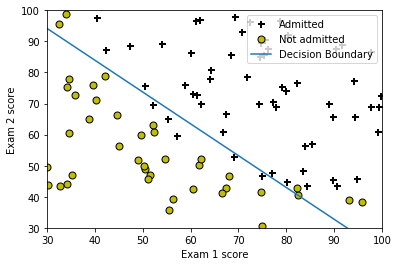
============== Part 4: Predict and Accuracies ==============
# Predict probability for a student with score 45 on exam 1
# and score 85 on exam 2
prob = sigmoid(np.matmul(np.array([1, 45, 85]), theta))
print('For a student with scores 45 and 85, we predict an admission '
f'probability of {prob:f}')
print('Expected value: 0.775 +/- 0.002\n')
# Compute accuracy on our training set
p = predict(theta, X)
print(f'Train Accuracy: {(p == y).mean() * 100:f}')
print('Expected accuracy (approx): 89.0')
For a student with scores 45 and 85, we predict an admission probability of 0.776291
Expected value: 0.775 +/- 0.002
Train Accuracy: 89.000000
Expected accuracy (approx): 89.0
Exercise 2: Regularized Logistic Regression
## Load Data
# The first two columns contains the X values and the third column
# contains the label (y).
data = pd.read_csv('ex2data2.txt', header=None)
X = data.iloc[:, :2]
y = data.iloc[:, 2]
plotData(np.array(X), np.array(y))
# Put some labels
# Labels and Legend
plt.xlabel('Microchip Test 1')
plt.ylabel('Microchip Test 2')
# Specified in plot order
plt.legend(['y = 1', 'y = 0'])
plt.show()
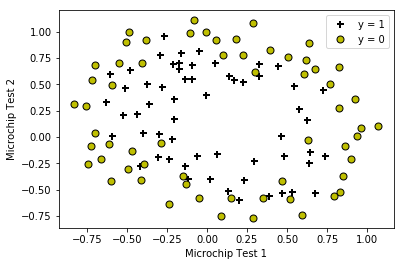
=========== Part 1: Regularized Logistic Regression ============
正则化的代价函数和梯度为
\[J(\theta) = \frac{1}{m}\left[\sum_{i=1}^{m}{-y^{(i)}\log\left(h_\theta(x^{(i)})\right) - (1 - y^{(i)})\log\left(1 - h_\theta(x^{(i)})\right)} + \frac{\lambda}{2}\sum_{i=1}^{n}{\theta_j^2}\right]\] \[= -\frac{1}{m}\left(y^T\log\left(g(X\theta)\right) + (\vec{1} - y)^T\log\left(\vec{1} - g(X\theta)\right)\right) + \frac{\lambda}{2m}\theta^T\theta\] \[\frac{\partial}{\partial\theta_j}J(\theta) = \frac{1}{m}\sum_{i=1}^{m}{\left(h_\theta(x^{(i)} - y^{(i)}\right)x_j^{(i)}} + \frac{\lambda}{m}\theta_j\] \[\nabla J(\theta) = \frac{1}{m}X^T\left(g(X\theta - y)\right) + \frac{\lambda}{m}\theta\]# Add Polynomial Features
# Note that mapFeature also adds a column of ones for us, so the intercept
# term is handled
X = mapFeature(X.iloc[:, 0], X.iloc[:, 1])
# Initialize fitting parameters
initial_theta = np.zeros(X.shape[1])
# Set regularization parameter lambda to 1
lambda_ = 1
# Compute and display initial cost and gradient for regularized logistic
# regression
cost, grad = costFunctionReg(initial_theta, X, y, lambda_);
print(f'Cost at initial theta (zeros): {cost:f}')
print('Expected cost (approx): 0.693')
print('Gradient at initial theta (zeros) - first five values only:')
print(f' {grad[:5]} ')
print('Expected gradients (approx) - first five values only:')
print(' 0.0085\n 0.0188\n 0.0001\n 0.0503\n 0.0115')
# Compute and display cost and gradient
# with all-ones theta and lambda = 10
test_theta = np.ones(X.shape[1])
cost, grad = costFunctionReg(test_theta, X, y, 10)
print(f'\nCost at test theta (with lambda = 10): {cost:f}')
print('Expected cost (approx): 3.16')
print('Gradient at test theta - first five values only:')
print(f' {grad[:5]} ')
print('Expected gradients (approx) - first five values only:')
print(' 0.3460\n 0.1614\n 0.1948\n 0.2269\n 0.0922')
Cost at initial theta (zeros): 0.693147
Expected cost (approx): 0.693
Gradient at initial theta (zeros) - first five values only:
[8.474576e-03 1.878809e-02 7.777119e-05 5.034464e-02 1.150133e-02]
Expected gradients (approx) - first five values only:
0.0085
0.0188
0.0001
0.0503
0.0115
Cost at test theta (with lambda = 10): 3.164509
Expected cost (approx): 3.16
Gradient at test theta - first five values only:
[0.346045 0.161352 0.194796 0.226863 0.092186]
Expected gradients (approx) - first five values only:
0.3460
0.1614
0.1948
0.2269
0.0922
============ Part 2: Regularization and Accuracies ============
# Initialize fitting parameters
initial_theta = np.zeros(X.shape[1])
# Set regularization parameter lambda to 1 (you should vary this)
lambda_ = 1;
# Set Options
fun = lambda t: costFunctionReg(t, X, y, lambda_)[0]
jac = lambda t: costFunctionReg(t, X, y, lambda_)[1]
options = {'disp': True, 'maxiter': 400}
# Optimize
res = opt.minimize(fun, initial_theta, jac=jac, options=options)
theta = res.x
J = res.fun
exit_flag = res.status
# Plot Boundary
plotDecisionBoundary(theta, X, y);
plt.title(f'$\lambda$ = {lambda_:g}')
# Labels and Legend
plt.xlabel('Microchip Test 1')
plt.ylabel('Microchip Test 2')
plt.legend(['y = 1', 'y = 0', 'Decision boundary'])
plt.show()
# Compute accuracy on our training set
p = predict(theta, X)
print(f'Train Accuracy: {(p == y).mean() * 100:f}')
print('Expected accuracy (with lambda = 1): 83.1 (approx)')
Optimization terminated successfully.
Current function value: 0.529003
Iterations: 47
Function evaluations: 48
Gradient evaluations: 48
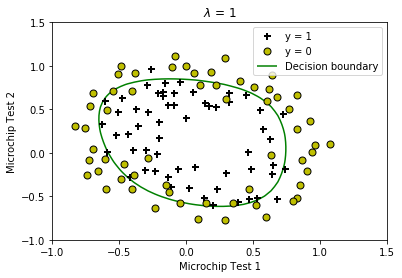
Train Accuracy: 83.050847
Expected accuracy (with lambda = 1): 83.1 (approx)
Different Regularization Parameters
# Plot Data
plotData(X[:, 1:], y)
# Set Options
fun = lambda t, lambda_: costFunctionReg(t, X, y, lambda_)[0]
jac = lambda t, lambda_: costFunctionReg(t, X, y, lambda_)[1]
options = {'disp': True, 'maxiter': 400}
lambdas = [0, 1, 10, 100]
colors = ['red', 'green', 'blue', 'yellow']
for lambda_, color in zip(lambdas, colors):
# Initialize fitting parameters
initial_theta = np.zeros(X.shape[1])
# Optimize
res = opt.minimize(fun, initial_theta, args=(lambda_,), jac=jac, options=options)
theta = res.x
J = res.fun
exit_flag = res.status
# Here is the grid range
u = np.linspace(-1, 1.5, 50)
v = np.linspace(-1, 1.5, 50)
z = np.zeros((len(u), len(v)))
# Evaluate z = theta * x over the grid
for i in range(len(u)):
for j in range(len(v)):
z[i, j] = np.matmul(mapFeature(u[i:i + 1], v[j:j + 1]), theta)
u, v = np.meshgrid(u, v)
#
# Plot z = 0
# Notice you need to specify the range[0, 0]
cs = plt.contour(u, v, z.transpose(), [0], linewidth=2, colors=color)
cs.collections[0].set_label('')
# Compute accuracy on our training set
p = predict(theta, X)
print(f'Train Accuracy: {(p == y).mean() * 100:f}')
plt.title('Different $\lambda$s')
# Labels and Legend
plt.xlabel('Microchip Test 1')
plt.ylabel('Microchip Test 2')
plt.legend(['y = 1', 'y = 0'] + [f'DB ($\lambda$ = {i})' for i in lambdas])
plt.show()
Warning: Maximum number of iterations has been exceeded.
Current function value: 0.263499
Iterations: 400
Function evaluations: 401
Gradient evaluations: 401
Train Accuracy: 88.135593
Optimization terminated successfully.
Current function value: 0.529003
Iterations: 47
Function evaluations: 48
Gradient evaluations: 48
Train Accuracy: 83.050847
Optimization terminated successfully.
Current function value: 0.648216
Iterations: 21
Function evaluations: 22
Gradient evaluations: 22
Train Accuracy: 74.576271
Optimization terminated successfully.
Current function value: 0.686484
Iterations: 7
Function evaluations: 8
Gradient evaluations: 8
Train Accuracy: 61.016949
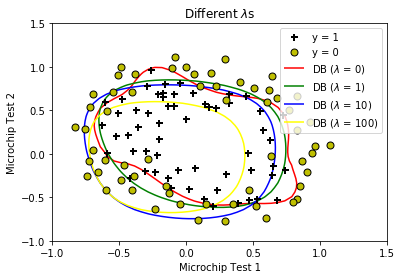
可以看到当\(\lambda = 0\)时迭代还没有收敛,并且决策边界变得很扭曲,说明没有经过正则化时出现了过拟合;
而当\(\lambda = 100\)时迭代了7步就收敛了,这时的决策边界相当圆滑,但较多的数据点分类不正确(准确率仅有61%),说明正则化程度过高会导致欠拟合。

